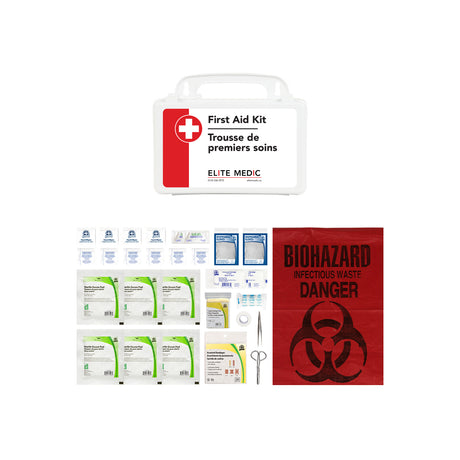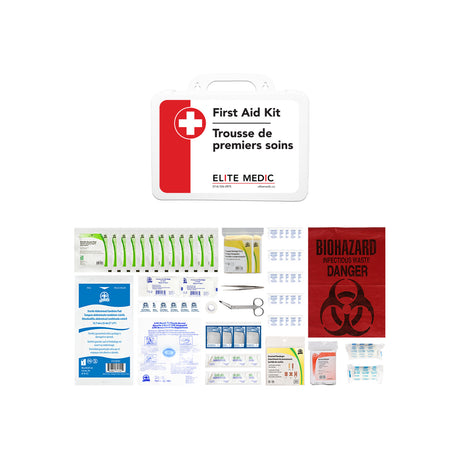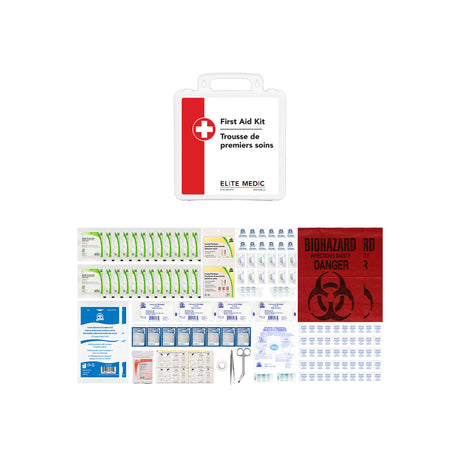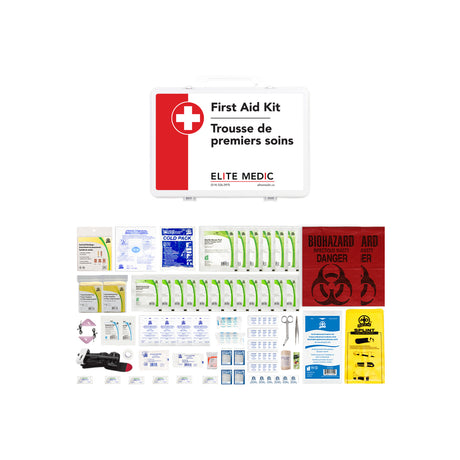First aid kits are very important, both at home and in the workplace. At Elite Medic, we are focused on providing you affordable, high-quality first aid kits. While home first aid kits can vary greatly in nature, workplaces have strict guidelines.
We offer first aid kits that are compliant with the CSA Z1220-17 Standard. That means our first aid kits are approved for use in the following provinces and territories:
- Ontario
- Alberta
- Quebec
- Saskatchewan
- Manitoba
- New Brunswick
- Newfoundland
- Northwest Territories
- Nunavut
- Prince Edward Island
- Yukon
NOVA SCOTIA - The updated CSA Z1220-24 has been adopted by Nova Scotia, effective August 1st, 2024. We are working to update our offering as our kits currently meets the CSA Z1220-17 standard, which is the CSA standard currently adopted in the province listed above.
In addition, different first aid kits fit in different context. Here is some guidance.
Solo work, remote work and vehicle first aid kits
That's exactly what the Personal First Aid Kit (CSA Type 1) is designed to address. This lightweight, portable kit includes all the staples required for self-administering first aid, such as assorted adhesive bandages, tweezers, triangular bandages and gauze.
This kit is economical, but it does not include resuscitation supplies as it is not designed for providing emergency care on someone else.
Low-risk workplaces
Most workplaces are considered low-risk, such as office work and most retail stores. In those environments, the Basic Workplace First Aid Kit (CSA Type 2) is the perfect solution. We offer that kit comes in two different sizes:
You can also mix and match multiple kits to reach the right number of kits. For example, if your workplace has no more than 200 employees on a given shift, you could have 4 small kits and 2 medium kits as the sum of those kits covers up to 200 employees.
Medium-risk and high-risk workplaces
The workplaces that fit the definition of medium-risk and high-risk workplaces are environments where serious injuries are possible due to the nature of the work. In those work environments, the Intermediate Workplace First Aid Kit (CSA Type 3) is designed to include all the supplies needed to treat life-threatening injuries. While it is open to interpretation, places such as construction sites, mining operations, heavy industrial machinery operations, etc. are typically considered medium- to high-risk workplaces. We offer that kit in a single size due to its size:
Just like the CSA Type 2 kits, you can get as many kits as necessary for the number of employees on shift at the same time.
How is the number of kits I need determined?
The number of kits you need is determined by the number of employees present at a given time. You should have enough kits or kits large enough to ensure they protect the number of employees present at any given time. That means that if the maximum number of employees at work at the same time is 30, you need either a medium kit (26-50 employees) or two (2) small kits (2-25 employees each).
Remote work
Even when employees work from home, they should have access to a first aid kit. We recommend getting the Personal First Aid Kit to address that need as working from home can be interpreted as working alone in the workplace.
British Columbia
Unfortunately, BC has not yet switched to the CSA Standard. Their standards, while similar, are not exactly the same. You can find all the BC first aid kit content requirements here. We do not currently offer those kits, but we do plan on adding them eventually.
Federal jurisdiction
Companies that fall under federal jurisdiction for health and safety, such as federal government agencies, crown corporations, telecom companies, airlines, etc. are subject to the Canada Occupational Health and Safety Regulations (Part XVI, Schedule II). We plan on offering those kits soon.
Still unsure about which kits you need? Contact us! We're happy to help.
Disclaimer: This guide is designed to provide information and context to help you get the right first aid kits for the workplace. It should not be considered legal advice, and you should refer to your local health and safety agency to ensure your compliance to their rules. We are not responsible for your compliance to health & safety guidelines, and having first aid kits is only one of the important requirements. This kit is regularly updated, but guidelines could change before we are made aware and update this guide. This page has been last updated on 2024-04-11.




